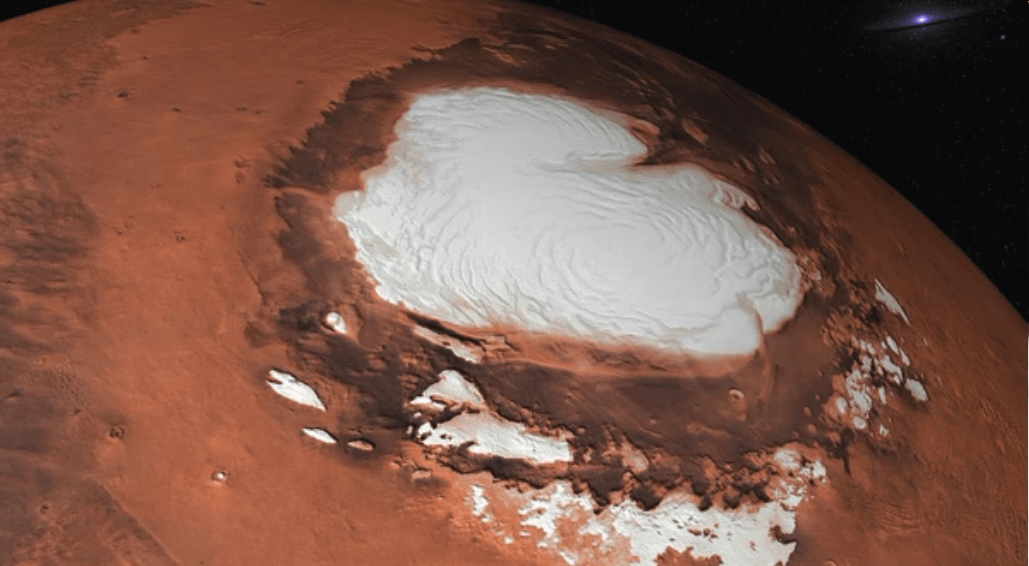The Oxygen Mystery On Mars: Alien Life?
The Mystery of Recent Mars Discovery: Could Alien Life be the Cause? We delve into the intriguing behavior of oxygen and methane on Mars.
Video of the day February 5th 2019
From what it means, to what could have caused it, join as we explore the question of the Recent Mars discovery by Nasaare being caused by Alien Life!
The Composition of Mars’ Atmosphere
Alright, so what exactly is going on with Mars this go around? I mean, we’re trying to get to the planet in terms of human ships within this new decade, so what could it possibly offer now that we haven’t found out about already? Well…more than you might realize. I mean, we’ve already found water and ice on Mars, and then we’ve found that it may have had all sorts of life in the past and a much greener composition before it had a hole in its atmosphere, so at this point, anything might have been possible. But what is stunning people at NASA and beyond right now is that there is oxygen on the planet…and we’re not sure how it got there, or how it’s being there in such amounts.
Now, obviously, the first question here is, “was there always oxygen on Mars?” And the answer is yes, the problem is the amount of Oxygen that it had. In fact, the Curiosity Rover that went to Mars spent three of its years (which is about 6 Earth years) studying the atmosphere of Mars by literally “inhaling” the gases that were around in the “air”, and the results that it spit out confirmed the makeup of the Martian atmosphere at the surface: 95% by volume of carbon dioxide (CO2), 2.6% molecular nitrogen (N2), 1.9% argon (Ar), 0.16% molecular oxygen (O2), and 0.06% carbon monoxide (CO). This is of course a stark difference from Earth itself where Carbon Dioxide is much lower, Oxygen is much higher, and there are other balances of the other gasses. So as you can see, Oxygen has always been on Mars, but that’s not the problem NASA scientists are having. The problem lies in its “behavior”.
“Wait, a gas has a behavior?” you might be wondering as you hear this? Well yeah! It has a behavior, just not a human one. Gasses on Earth, and in the atmospheres of other planets have a “behavior” in regards to its rising and falling levels. Usually, this is based on what goes on in the atmosphere and on the planet in terms of seasons. And Mars is no different, which is why the scans from the Curiosity Rover are so compelling, and so confusing.
The Curiosity Rover’s Findings
It revealed how the molecules in the Martian air mix and circulate with the changes in air pressure throughout the year. These changes are caused when CO2 gas freezes over the poles in the winter, thereby lowering the air pressure across the planet following redistribution of air to maintain pressure equilibrium. When CO2 evaporates in the spring and summer and mixes across Mars, it raises the air pressure.
Within this environment, scientists found that nitrogen and argon follow a predictable seasonal pattern, waxing and waning in concentration in Gale Crater throughout the year relative to how much CO2 is in the air. They expected oxygen to do the same. But it didn’t. Instead, the amount of the gas in the air rose throughout spring and summer by as much as 30%, and then dropped back to levels predicted by known chemistry in fall. This pattern repeated each spring, though the amount of oxygen added to the atmosphere varied, implying that something was producing it and then taking it away.
Needless to say…when scientists first realized this pattern, they were a bit…confused.
“We’re struggling to explain this,” said Melissa Trainer, a planetary scientist at NASA’s Goddard Space Flight Center in Greenbelt, Maryland who led this research. “The fact that the oxygen behavior isn’t perfectly repeatable every season makes us think that it’s not an issue that has to do with atmospheric dynamics. It has to be some chemical source and sink that we can’t yet account for.”
Believe it or not, this isn’t the only gas that’s on Mars that is causing scientists to shake their heads at the randomness of its rising and falling levels. The other one is Methane, which in the Gale Crater sometimes rises in levels of up to 60% in the Summer…but then the rest of the years falls to such levels that it’s barely readable by scanners.
Since there is two different gasses on Mars causing a mystery in terms of levels and such, some scientists are wondering if there is a connection:
“We’re beginning to see this tantalizing correlation between methane and oxygen for a good part of the Mars year,” said Sushil Atreya, professor of climate and space sciences at the University of Michigan in Ann Arbor. “I think there’s something to it. I just don’t have the answers yet. Nobody does.”
Is there a connection between these two? It’s possible, and if it’s not explainable by science as we know it right now, then that means there’s a factor in the equation that we just don’t know about yet. And a lot of people are wondering if that factor…is life.
The Mystery of Oxygen Levels
Now don’t get me wrong here, I’m not talking about Martians, or even animal life that is underneath the ground (though we technically can’t rule out the second one just yet as we haven’t drilled into Mars deep enough to make that proclamation), more than likely there are bacteria, microbes, other microscopic life that is contributing to this massive increase of Oxygen and Methane in the air and atmosphere. Though obviously there are other possibilities for what this is:
“We have not been able to come up with one process yet that produces the amount of oxygen we need, but we think it has to be something in the surface soil that changes seasonally because there aren’t enough available oxygen atoms in the atmosphere to create the behavior we see,” said Timothy McConnochie, assistant research scientist at the University of Maryland in College Park and another co-author of the paper.
But let’s stick with the life idea for a bit though, after all, that’s why you’re here right?
Alright, so let’s just say that there is life on Mars, in the terms of the bacteria or microscopic life that I had noted earlier. What would that mean for Mars as a whole? Well on the surface (see what I did there?) it would mean that Mars has much more to offer us than before. As well as proving that there are an infinite number of surprises that it might just hold for us.
But sticking with the life aspect, if we do find things like this, it could mean that there is even more life on Mars than we anticipated. After all, despite all the pictures and such, we honestly only have researched a certain region of the planet. We haven’t been all the way around it, not even close. The recent focus on the Gale Crater was because of timing and past results with other rovers, which is good because that’s where everything that’s been exciting on Mars has been found recently. Anyway, if the life is within the crater, somewhere in the soil and ground beneath, that could mean that there are other spots like this all around Mars. Clearly it’s not all over Mars or it would’ve been detected earlier, much earlier in fact. But the fact that it’s seasonal, and is happening in AT LEAST one spot proves that SOMETHING is causing it, whether it be chemical or organic in nature.
But if it is organic, and IF we can get samples of it, and figure out how it’s doing this thing, that could quite literally change everything for us on Mars. Not just because we discovered life of some kind, but because of what we might be able to use it for.
Possible Connections between Oxygen and Methane
How so? Well recall the gas composition of the Mars atmosphere, it’s not exactly breathable for humans. But, IF we could get this…let’s say bacteria, and figure out how and why it’s able to produce such oxygen in the atmosphere at certain rates, we may be able to do get it to do that on command…and give us a breathable air supply.
Granted, it wouldn’t be able to just fill up the atmosphere with oxygen (though that is something that could happen in the future as I’ll explain later), but if we were to live in a human colony, we would likely be in a dome or something of the like. Recycled Oxygen would be the way to sustain us long term, but where would the Oxygen come from at first? Yeah, we’d have tanks of oxygen that would fuel things like suits, but for a colony? That’s another matter. These bacteria could help give us the levels we’d need to fill up a colony and make it livable long-term. As well as be a back-up plan should something go wrong with the Oxygen recyclers.
Now, in the long term, if we could do this en masse with the bacteria or other organisms, we could do something with Mars that has only been theorized for a long time…terraforming.
Terraforming Mars: Changing the Red Planet
Oh yeah, we’re going to change Mars at its core level and above! Terraforming is the act of changing a land from one nature to another. So in the case of Mars, turning it from a barren red wasteland to an area where we can live, breathe, and grow things without the need of a suit, dome, or other avenues. I talked about in this post.
Of course, the biggest problem with this is the atmosphere and the magnetic field of the planet. The atmosphere of Mars has a massive whole in it, which is why there’s no water in liquid form on the surface (that we know of, the water comes from ice at the polar caps). It’s also why the gasses on the planet are so much different from Earth’s. As for the magnetic field, the one that was on the planet was destroyed alongside the atmosphere, and because of that, solar radiation and other dangerous things bombard the planet. That’s why the temperature is so hot or cold on the planet depending on the season or position of the planet to the sun. It’s not anywhere near as balanced as Earth’s, and because of the lack of a magnetic field, cosmic radiation can bombard the planet, and with no strong atmosphere, Mars has been consistently pelted by meteors over the centuries and millenia.
BUT…if we were able to “fix” the atmosphere (which isn’t as audacious as it sounds, trust me) and figure out a way to subvert the magnetic field properties, we could use the bacteria or other organism to flesh out the atmosphere, rise the oxygen levels of the planet in such a way that it would allow us to live on Mars more freely, and thus (with other methods already in the works) make a planet much more habitable to live on. Even we did this for a singular region, like a country-sized area (which honestly does have merit and plans for it right now…) that would be a huge difference in the plans to colonize Mars.
Methane as an Energy Source
Oh, and if we did that with the Methane ones too? Methane is an energy source, and thus we could use it to power just about anything on the planet! Win-win!
And yeah, there’s also the thing about how we discovered life on another planet, that’s cool too. I’m sure some people will be excited by what that might mean for the universe as a whole…no big deal…
I kid, obviously this discovery on a universal scale will change how we view other planets and the universe as a whole. Because even if it’s small, it would mean that there is life on another planet not named Earth! That would be huge in all the ways that matter and beyond!
Because now, we’d have hope for finding more and more kinds of life on all other planets. Even the ones that may not seem to have life on them at all! We could see the surface and see “nothing”, but remember Mars and think, “Maybe it’s just underneath the surface!”
Exploring Other Planets for Life
Now yeah, playing devil’s advocate, it’s very possible that what is happening on Mars with the Oxygen and Methane doesn’t have to do anything with life at all. Like some are speculating, it could be something involving the dirt in certain seasons, or a wellspring of gasses trapped underneath the ground that is only exposed in certain seasons and what not. It’s possible, very possible even. But we don’t know the answer yet, and because of this, we’re getting excited.
Well, some people are going crazy because they can’t figure it out yet, and scientists HATE IT when they can’t figure something out, but for those who still have wonder in their hearts, they’re excited.
This mystery is recent, and fresh, and so there is going to be a lot of people on this, every one bringing their knowledge to bear so that they can try and figure it out.
And as the scientists have noted, if they can’t solve it, maybe you or someone else can. The challenge has been laid down if you want to try and figure it out for yourself. I’m just saying.
“This is the first time where we’re seeing this interesting behavior over multiple years. We don’t totally understand it,” Trainer said. “For me, this is an open call to all the smart people out there who are interested in this: See what you can come up with.”
subscribe to the insane curiosity channel

Subscribe For the Latest news & Updates
Subscribe For the Latest news & Updates
Get in touch with the Insane Curiosity Channel. Once in while you will receive emails about news, promos, and much more. Stay Tuned!
Insane Curiosity
Science made easy
Who we are
Insane Curiosity is a channel of astronomy, physics and future technology, which easily explain science. We need science and science need us!
Info and contacts

